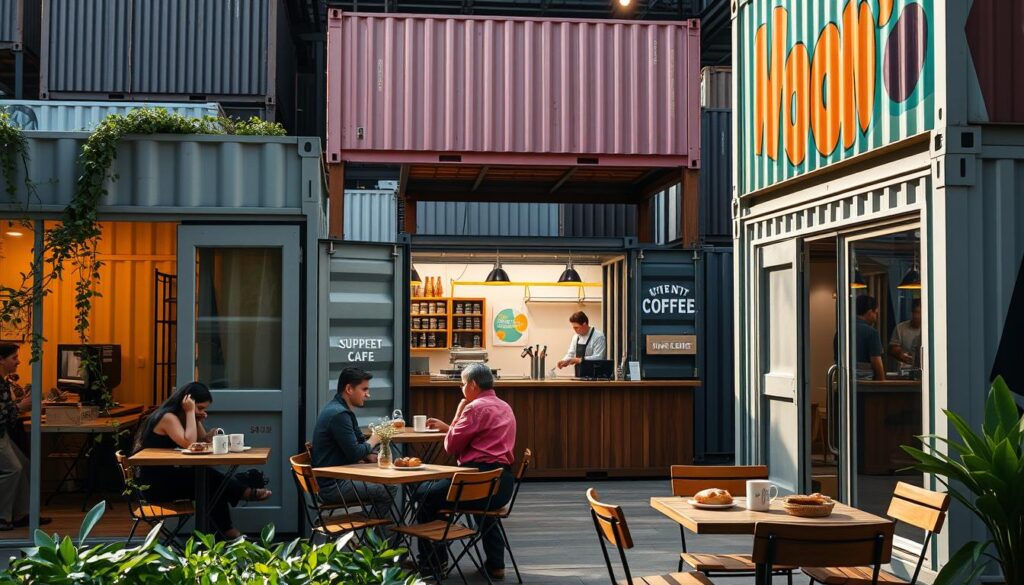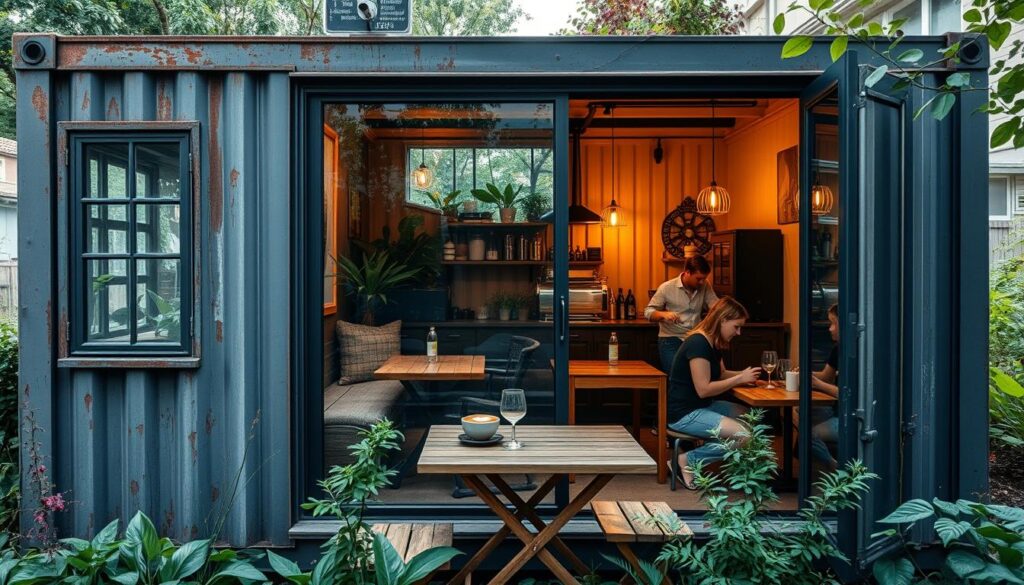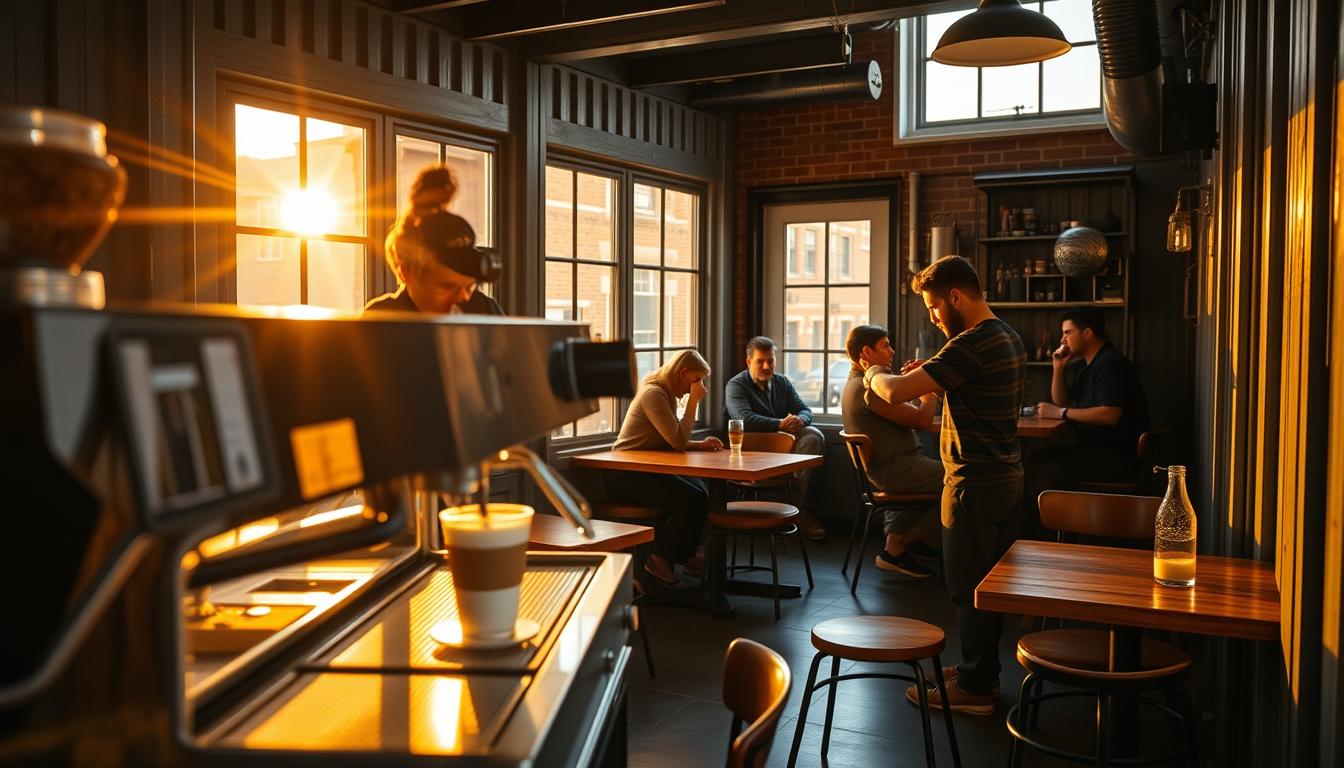Can a repurposed shipping container become the perfect spot for your daily coffee fix? This question is at the heart of a growing trend that’s transforming the coffee shop landscape.
Shipping Container Cafés are on the rise, offering a unique blend of sustainability and style. By converting old shipping containers into cozy coffee shops, entrepreneurs are reducing waste and crafting distinctive spaces that attract coffee lovers.
This innovative approach to coffee culture is not just about aesthetics; it’s also about encouraging creativity in design and layout within a compact footprint.
Key Takeaways
- Shipping Container Cafés are a growing trend in the coffee industry.
- These cafes promote sustainability by repurposing old shipping containers.
- The compact nature of these cafes fosters creative design and layout.
- They offer a unique coffee culture experience.
- Shipping Container Cafés are transforming the way we think about coffee shops.
The Rise of Shipping Container Cafés
The rise of shipping container cafés marks a significant innovation in mobile café design and innovative café concepts. These unique establishments are not only redefining the coffee shop experience but also contributing to a more sustainable urban environment.
From Industrial to Innovative: The Evolution of Container Repurposing
Shipping containers have been used for decades in transportation, but their repurposing into cafes is a relatively new trend. This shift reflects a broader movement towards sustainable and creative uses of industrial materials. As noted on Container Trends, the repurposing of shipping containers is gaining momentum, driven by their potential for innovative applications.
Historical Context of Shipping Containers
Originally designed for cargo transport, shipping containers have played a crucial role in global trade. Their durability and versatility have made them an attractive material for repurposing. As innovative café concepts continue to emerge, the historical significance of shipping containers is being reimagined in the context of modern coffee culture.
Transition to Architectural Applications
The transition of shipping containers from industrial use to architectural applications is a testament to their adaptability. As sustainable building practices gain popularity, shipping container cafés are becoming an integral part of urban landscapes. According to industry insights, “the use of shipping containers in café design represents a forward-thinking approach to sustainable development.”
“The use of shipping containers in architectural projects is revolutionizing the way we think about space and design.”
The evolution of shipping container repurposing into café spaces is a story of innovation and adaptation. As the trend continues to grow, it’s clear that shipping container cafés are here to stay, offering a unique blend of sustainability, creativity, and community.
Shipping Container Cafés: Creating a Compact Coffee Culture
With their eco-friendly design and compact footprint, shipping container cafés are redefining the modern coffee shop. These innovative establishments are not only changing the way we consume coffee but also how we experience it.
Defining the Container Café Movement
The container café movement is characterized by its emphasis on sustainable café solutions and small space dining. By repurposing shipping containers, these cafés reduce waste and create unique, cozy environments for customers.
Key Characteristics of Container Cafés
- Compact size, ideal for urban areas with limited space
- Eco-friendly design, utilizing recycled shipping containers
- Unique, industrial-chic aesthetic that attracts customers
- Flexibility in design, allowing for easy modification and expansion
Distinguishing Features from Traditional Cafés
Container cafés differ significantly from traditional cafés in their approach to sustainability and spatial efficiency. For instance, they often incorporate reclaimed materials and energy-efficient systems, setting a new standard for eco-friendly dining experiences. To learn more about the innovative designs of container cafés, visit Bmarko Structures for insights into their construction and operation.
The compact nature of container cafés also encourages a more intimate and engaging customer experience. By focusing on small space dining, these establishments can offer a more personalized service, enhancing customer satisfaction and loyalty.
In conclusion, the container café movement is not just a trend; it’s a shift towards a more sustainable and compact coffee culture. As consumers become more environmentally conscious, the demand for sustainable café solutions is likely to grow, making container cafés an attractive option for entrepreneurs and coffee enthusiasts alike.
Design Considerations for Container Cafés
Effective design is crucial for shipping container cafés, where space is limited and every square foot counts. To create a successful container café, owners must balance functionality with aesthetics, ensuring a welcoming atmosphere for customers while maintaining an efficient workflow.
Spatial Planning in Limited Square Footage
The compact nature of shipping container cafés demands careful spatial planning. This involves optimizing the layout to accommodate both customer seating and operational areas, such as the coffee bar and kitchen.
Optimizing Workflow in Narrow Spaces
To optimize workflow in narrow spaces, consider the following strategies:
- Implement a linear workflow to minimize congestion
- Utilize vertical storage to keep equipment and supplies off the countertops
- Position the coffee bar and kitchen equipment to facilitate efficient service
Customer Seating Strategies
Customer seating is another critical aspect of spatial planning in container cafés. To maximize seating capacity, consider using:
- Compact tables and chairs
- Benches or banquettes along the container walls
- Outdoor seating areas, if possible, to expand capacity
By carefully planning the layout and optimizing both workflow and customer seating, shipping container cafés can create a compact coffee culture that is both functional and inviting.
Technical Requirements and Modifications
To create a welcoming and safe environment, shipping container cafés must undergo substantial modifications. These modifications are crucial not only for aesthetic appeal but also for ensuring the structural integrity and functionality of the container.
Structural Modifications and Reinforcements
The process of converting a shipping container into a café involves significant structural changes. “The key to a successful conversion lies in balancing the original structure with the necessary modifications to create a functional and inviting space,” says an expert in mobile café design.
Wall Removal and Support Systems
One of the primary modifications involves the removal of walls to create an open-plan space. However, this requires careful planning to maintain the structural integrity of the container. Installing support systems is essential to compensate for the removed walls and ensure the container’s stability.
Flooring and Ceiling Adaptations
Adaptations to the flooring and ceiling are also critical. The original flooring may need to be reinforced or replaced to support the weight of café equipment and customers. Similarly, ceiling adaptations may be necessary to accommodate lighting and ventilation systems, enhancing the overall ambiance of the café.
Key Considerations for Modifications
- Assessing the container’s original structure
- Planning for support systems during wall removal
- Upgrading flooring and ceiling to meet café standards
- Incorporating energy-efficient and aesthetic lighting solutions
As highlighted by a successful café owner, “The right modifications can turn a simple shipping container into a thriving café, providing a unique experience for customers.”
By focusing on these technical requirements and modifications, entrepreneurs can create a unique and functional mobile café design that stands out in the competitive coffee scene.
Business Advantages of Container Cafés
Container cafés offer a compelling alternative to traditional coffee shops, leveraging innovative café concepts and small space dining solutions. These establishments are not only unique in their design but also provide several business advantages that make them an attractive option for entrepreneurs.
Cost-Effectiveness Compared to Traditional Builds
One of the primary advantages of container cafés is their cost-effectiveness compared to traditional builds. The initial investment required for setting up a container café is significantly lower than that of a conventional coffee shop.
Initial Investment Comparisons
The initial investment for a container café includes the cost of the shipping container, modifications, and equipment. In contrast, traditional coffee shops require expenses related to property acquisition or leasing, construction, and equipment. Studies have shown that container cafés can be set up at a fraction of the cost of traditional coffee shops.
Operational Cost Differences
In addition to lower initial investments, container cafés also offer operational cost savings. Their compact size means lower utility bills and maintenance costs. Furthermore, the modular design of container cafés allows for easier expansion or relocation if needed, providing a flexible business model.
The business advantages of container cafés extend beyond cost savings. They offer a unique selling proposition due to their distinctive and modern aesthetic, attracting customers looking for a novel coffee experience. Moreover, the sustainability aspect of repurposing shipping containers appeals to environmentally conscious consumers.
Starting Your Own Container Café Business
As the demand for sustainable café solutions grows, entrepreneurs are turning to container cafés as a unique business venture. This trend is driven by consumers’ increasing preference for eco-friendly options and the distinctive appeal of Shipping Container Cafés.
Business Planning and Financing
Effective business planning and financing are crucial for the success of a container café. This involves developing a comprehensive business plan that outlines financial projections, marketing strategies, and operational logistics.
Container Café-Specific Business Models
Entrepreneurs have several business models to consider when opening a container café. These include:
- Specialty coffee shops focusing on high-quality, artisanal coffee
- Cafés offering a unique experience, such as coffee tastings or brewing workshops
- Mobile or pop-up container cafés that can be relocated to different events or locations
Funding Options and Considerations
Securing funding is a critical step in launching a container café business. Options include traditional bank loans, crowdfunding, and investors. It’s essential to consider the costs associated with purchasing and modifying shipping containers, as well as ongoing expenses such as staffing and inventory.

By understanding the specific business models suited to container cafés and exploring available funding options, entrepreneurs can set their businesses up for success in the competitive coffee market. With careful planning and a focus on sustainability, Shipping Container Cafés can thrive as unique and eco-friendly destinations.
Sustainability Aspects of Container Cafés
Sustainability is at the heart of the container café movement, driven by upcycling and reducing waste. Container cafés contribute significantly to the compact coffee culture by repurposing shipping containers, thereby reducing the need for new construction materials and minimizing waste.
Upcycling and Reducing Construction Waste
By upcycling shipping containers, container cafés embody a sustainable approach to business. This method not only reduces construction waste but also gives a new life to structures that would otherwise be discarded. The result is a unique, eco-friendly café that appeals to customers who value sustainable practices.
Environmental Impact of Container Reuse
The reuse of shipping containers for cafés significantly reduces the environmental impact associated with traditional construction methods. It decreases the demand for raw materials, lowers energy consumption, and minimizes waste. This approach aligns with the growing consumer preference for businesses that prioritize environmental sustainability.
Sustainable Material Integration
In addition to upcycling containers, many container cafés integrate other sustainable materials into their design. This can include reclaimed wood, energy-efficient appliances, and eco-friendly finishes. Such practices further enhance the café’s sustainability profile, making it an attractive option for those seeking an environmentally responsible dining experience.
The combination of upcycling, reducing waste, and integrating sustainable materials makes container cafés a compelling choice for entrepreneurs looking to establish an eco-friendly business. As the demand for sustainable and mobile café designs continues to grow, container cafés are poised to play a significant role in shaping the future of the coffee industry.
Successful Container Café Case Studies
By examining successful container café case studies, we can gain insights into their appeal and potential for transforming city spaces. Container cafes have emerged as a vibrant part of urban landscapes, offering unique innovative café concepts that captivate customers.
These establishments not only serve specialty coffee but also become landmarks in their own right, contributing to the character of their surroundings.
Urban Container Cafés Transforming City Spaces
Urban container cafes are at the forefront of redefining small space dining experiences. By repurposing shipping containers, these cafes bring a fresh perspective to urban development.
Stumptown Coffee’s Container Outpost in Portland
Stumptown Coffee’s container outpost in Portland is a prime example of an innovative café concept. This café combines high-quality coffee with a unique, compact environment that encourages customer engagement.
The Rise of Container Food Parks in Austin
Austin has seen a surge in container food parks, which often feature coffee and café options. These parks demonstrate the versatility of container cafes in creating vibrant, communal dining spaces.
| Location | Café Concept | Key Features |
|---|---|---|
| Portland | Stumptown Coffee | Compact design, high-quality coffee |
| Austin | Container Food Parks | Variety of food options, communal atmosphere |

The success of these container cafes highlights their potential for transforming urban environments. As container café culture continues to evolve, it’s likely we’ll see more innovative café concepts emerge.
By embracing small space dining and repurposing existing structures, container cafes are not only reducing their environmental footprint but also enriching urban landscapes.
Conclusion: The Future of Container Cafés in America’s Coffee Landscape
The rise of shipping container cafés is transforming the coffee scene in the United States, driven by their unique blend of sustainability and compact design. As consumers increasingly prioritize eco-friendly experiences, these innovative cafés are well-positioned for growth, providing sustainable café solutions that meet the demands of a changing market.
With their focus on upcycling and reducing waste, container cafés embody a forward-thinking approach to business, aligning with the values of environmentally conscious consumers. As the coffee industry continues to evolve, the popularity of container cafés is likely to endure, driven by their ability to deliver distinctive customer experiences within a compact footprint.
By embracing sustainable café solutions, entrepreneurs can capitalize on a growing trend, creating unique and engaging environments that resonate with customers. As the market continues to shift towards eco-friendly and experiential dining, the future of container cafés in America’s coffee landscape looks bright.

